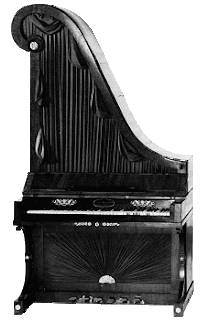
I'm really enjoying tuning the harpsichord over at the University of Rhode Island for their Bach Ensemble. I don't get to tune a non-equal temperament very often. When I first started work there, I asked them what temperament they would like me to use. I had my Jorgensen in hand, ready to roll! But they were so astonished that I was willing to tune it at all, they just said use whatever temperament you want.
The harpsichord was built by Eric Herz, a well-known builder from Boston. No one in the department seems to know exactly how old it is, and I can't find a serial number (though I found a number in chalk on one of the beams underneath). It was apparently one of Herz's earlier ones. It's a small 'chord, one manual, two ranks, very pretty sounding, nice craftsmanship.
So what temperament did I use? Before I name it, I'll tell you where I got it and how it's tuned. I received a call a few years ago from an instrument maker on the West Coast who was building a clavichord for a customer of mine. Apparently my customer was going to have me tune it, so the builder wanted to speak with me. He explained what temperament he was going to use in the design, and gave me a website where I could find instructions.
The easiest way to describe the temperament is by indicating how the fifths should be tuned, which is appropriate for a well temperament (the comma I'm referring to here is the Pythagorean comma):
F - C, C - G, G - D, D - A, A - E (-1/6 comma)
E - B, B - F#, F# - C# (0 comma)
C# - G#, G# - D#, D# - A# (-1/12 comma)
A# - F (+1/12 comma)
The surprise is that last fifth being stretched.
Here's a quick explanation. In Western music, we insist that 12 fifths laid end-to-end will equal 7 octaves. Nature has other ideas, however, and 12 pure fifths is slightly greater than 7 octaves. The difference is called the comma, and the question is, what do we do with it? In equal temperament, we divide it equally among all 12 fifths by shrinking each fifth the same amount, 1/12 of a comma. Tempered thus, the 12 fifths do indeed equal 7 octaves, and the fact that the fifths are shrunk is hardly noticed, or at least we learn to not notice the effect.
So with this temperament, the first 5 fifths are each shrunk twice what they would be in equal temperament. The next 3 fifths are tuned pure. The next 3 fifths are tuned as they would be for equal temperament. If you add up all the tempering at this point, we have overshot the comma by 1/12, so that last fifth is tuned so that it sounds like an equal tempered fifth, but it's stretched.
Now the 12 fifths line up to equal 7 octaves, but the fifths do not sound all the same, as they do in equal temperament. Nor do the thirds all sound alike, or the sixths, or any other intervals. In fact, each of the 12 keys will sound a little different, will have a slightly different "color." It's key color that is missing from equal temperament.
The most famous proponent of well temperament was Johann Sebastian Bach, who wrote an entire series of pieces using all 12 keys (plus 12 more enharmonic keys) called The Well-Tempered Clavier. So which temperament did he use? No one knows, but at least one person claims that the very temperament I've described here is, in fact, old Bach's.
This is a scholarly hornet's nest I'd rather avoid; go visit the website yourself (link below). I've used this temperament on harpsichords, clavichords, and even a piano, and whether or not it's Bach's, it works very nicely - nice key color, no wolf intervals, works in all keys. It's quick and easy to tune once you get the hang of it.
Related websites:
Bradley Lehman's website on temperaments
The PTG's page on Owen Jorgensen



















0 comments:
Post a Comment